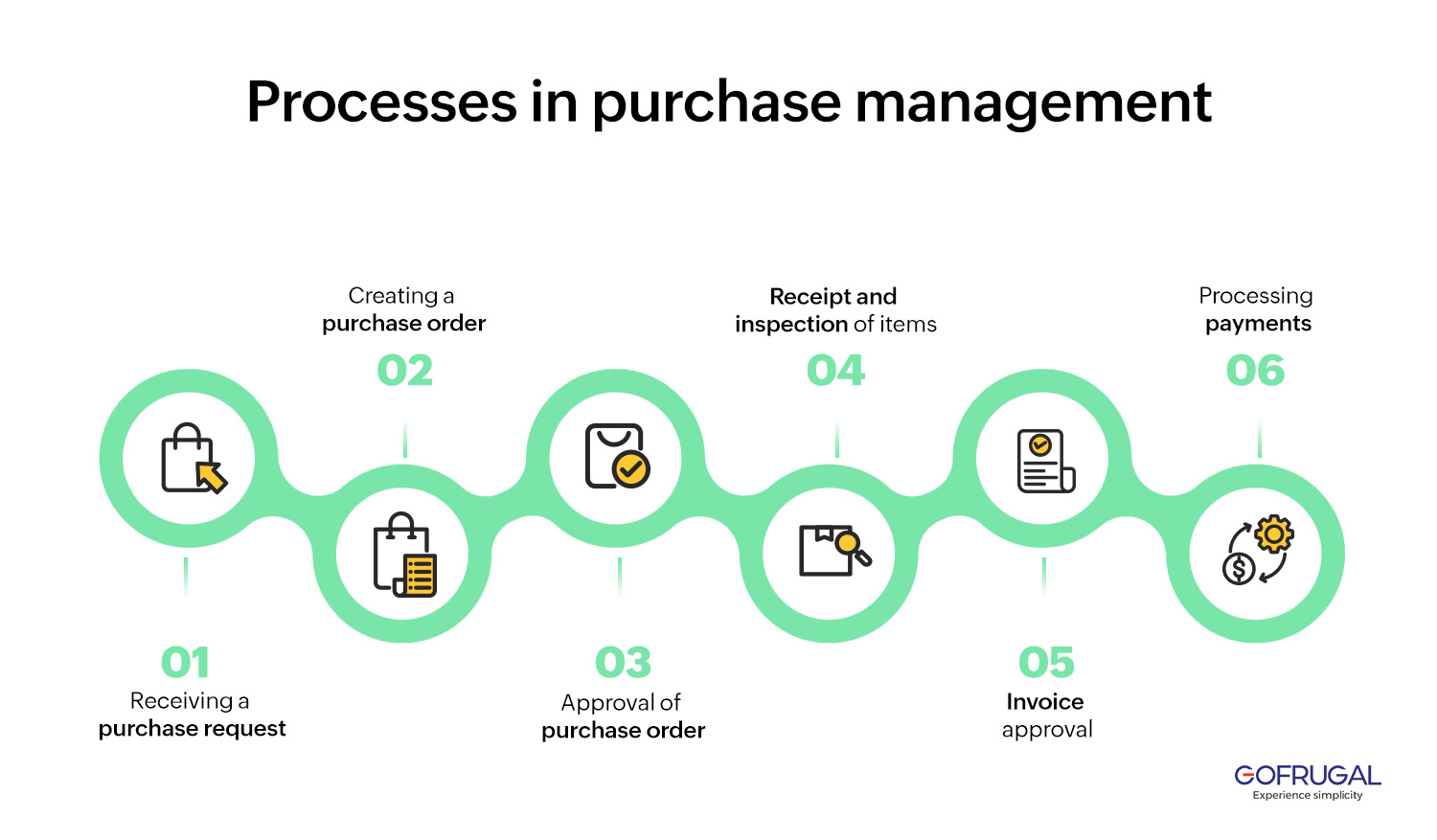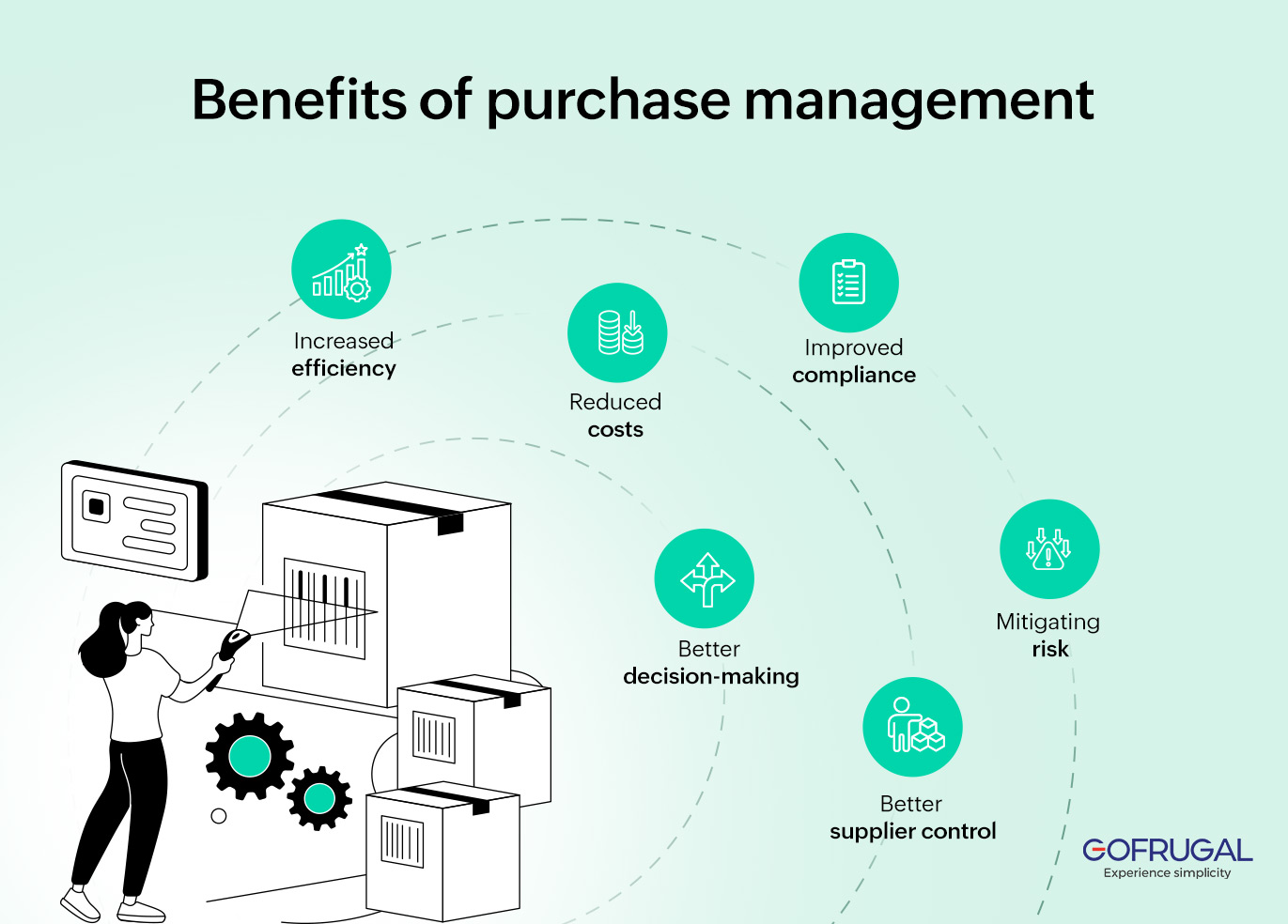Purchase management is a crucial process in retail since the efficiency of every activity that follows begins with the accuracy of the purchase decisions made. Purchasing the right products in the right quantity at the right time and at the minimum cost contributes to improving the bottom line of the business. That said, purchasing management is a vital function that requires a diverse skillset to handle multiple activities from planning to execution.
Table of Contents
- What is purchase management?
- Why is purchase management required?
- What are the processes in purchase management?
- Benefits of purchase management
- Best practices in purchase management
- How Gofrugal helps in efficient purchase management?
What is purchase management?
Purchase management process is the process of procuring goods from suppliers based on current inventory and customer demand, to increase the store's stock level. Purchasing management process begins with receiving purchase order requests, followed by various activities such as raising purchase orders, receiving goods, clearing invoices, processing payments, and finally ending with record keeping.
Why is purchase management required?
Guaranteeing availability of sufficient inventory
In retail businesses, continuous availability of items in racks is vital to ensure a smooth customer shopping experience. Process of purchase management should be done at the right time, and refilling should happen before items get stocked out to ensure racks are always filled with necessary items as per customer needs.
Ensuring raw materials are ready for production
In order to ensure demand for each variant of private labeled items is met at every store, production planning should be done efficiently. For that, bulk items should be purchased from suppliers in advance and less frequently, so the items are ready for transfer when needed.
Efficient maintenance of transactions
Purchase management system can be effective only when all the transactions are recorded and available to refer to in the future. Maintaining records of purchases helps track orders, deliveries, and material inwards. These purchase transactions tracked as reports help interpret past data and predict demand better.
Assuring transparency in purchases
Transparent purchase management process reduces confusion and miscommunication between different teams in a retail business. When purchases are documented transparently with a streamlined purchase management system, all team members are aware of where the money is spent, and it enables them to plan inventory, warehouse operations, refilling, transfers, and clearance sales with discounts or offers.
Purchasing required items at best price
The primary objective of the purchase team is to source and procure top quality items at best possible price during purchasing management process. This is possible only when information about multiple suppliers providing the item, previous purchase history, and purchase margins are known so you can make well-informed purchase decisions.
Meeting standards and statutory needs
The purchase management process involves a mutual agreement of payment and logistics terms, discounts, taxes, delivery dates, and other terms and conditions with suppliers. During conflicts with suppliers, recorded purchase transactions can help win arguments. Purchase management helps businesses meet the statutory needs of accounting and auditing, too.
Make the relevant data available to other teams
The purchase management team is interlinked with multiple teams like warehouse, finance, and sourcing. Therefore, it's necessary for them to have easy accessibility of purchase-related data to complete their operations. Such cross functional access to purchasing management information helps them review, analyze, and control data to make important decisions for the business.
6 essential purchasing management process
1. Receiving a purchase request
A purchase request with item details, specifications, purpose, and quantity is sent by the inventory or warehouse team to the purchase management team. This document will be verified and validated before raising an actual purchase order.
2. Creating a purchase order
Once a supplier is shortlisted and items to procure are finalized, a formal purchase order for the necessary items is raised with details like item descriptions, quantities, UOM, payment terms, expected delivery dates, freight charges, and agreed terms and conditions.
3. Approval of purchase order
In order to ensure a purchase doesn't exceed the budget, purchase orders are scrutinized by the purchase manager or business owner before being sent to suppliers. They have the freedom to approve completely, approve partially, suggest changes, or reject the purchase request considering the impact the purchase will make on the business.
4. Receipt and inspection of items
After the purchase order is raised from a purchase management system, the supplier gets the items ready, does the shipment, and delivers them at the store or warehouse. The purchasing management team inspects the delivered items for adherence to the specifications and quality standards, notes down any deviations, and processes the goods receipt note (GRN) to add the items to the available inventory.
5. Invoice approval
A copy of the invoice will be sent by email, post, or physically handed over along with the shipped items by the supplier. The purchasing management team compares items and their quantities in terms of ordered versus delivered; validates the value of the PO raised and invoice value; and discusses the quality, items and quantity mismatches, and payment adjustments with the supplier.
6. Processing payments
After the invoice approval, payment is initiated to the supplier as per the agreed terms and time to maintain a good relationship with the supplier. It marks the end of purchase management process. While making the payment, returns, refunds, and pending collections are considered and paid accordingly for accurate accounting and audit compliance.
Benefits of purchase management
Increased efficiency
Purchase management helps streamline the purchase process, eliminate human errors, and standardize routine tasks. Consolidated purchases with a comprehensive purchase management system help reduce the efforts, minimize planning time, assure faster execution, and improve purchase efficiency.
Reduced costs
The purchasing management process reduces expenses for the business strategically through efficient negotiations, ordering with better gatekeeper margins, and getting a better price for bulk purchases. Operationally purchasing management it aids in reducing waste, minimizing inventory carrying costs, avoiding duplicate purchases, and overlapping orders.
Improved compliance
Having a purchase management process ensures compliance with regulatory laws, quality standards, and ethical standards such as anti-bribery laws, shipping and packaging conditions, faulty or damaged item protection, compliance audits, theft protection, and audit trails.
Better decision-making
Tracking purchases efficiently through purchase history and insightful reports ensures only the right products are ordered, from the correct supplier, at the right time, and for the lowest price. It helps to delve further into stock movement, and make optimized purchases thereby avoiding stockouts as well as overstocking.
Better supplier control
A purchase management system allows businesses to manage multiple suppliers, monitor their service levels, provide feedback, and improve their performance. It helps to maintain and achieve the scheme targets and maintain better supplier relationships, assuring favorable pricing, better service, agreeable terms, and early access to new products.
Mitigating risk
Purchase management process helps businesses identify and mitigate risks linked to procurement, such as poor supplier performance, quality issues, supply chain disruptions, pricing hikes, and delayed deliveries by preparing contingency plans and expanding the supplier base.
Best practices in purchasing management
Define standard policies and procedures
Establish clear standard operating procedures and procurement policies as a part of purchase management process, and make them accessible to the entire purchasing management team to ensure a consistent purchase process, reduce risks, and enable a faster order generation for the processing cycle.
Finalize the purchasing power and cycle
Define budget limits for placing purchase orders based on the role and restrict excess spending by staff by having managers validate bulk purchases. Identify the supplier walk-in date, give orders as per the schedule, and streamline the purchasing management process.
Analyze supplier performance regularly
Monitor purchase patterns, purchase margins, and supplier fulfillment rates to identify shortcomings early. Analyze reports and discuss poor service or item quality with suppliers to react and take actions quickly.
Centralize your purchase process
Source the demand from each store, make a central purchase order with the supplier, and receive and allocate stock centrally. This eliminates duplicate purchases, avoids overspending, reduces time, and improves productivity.
Implement smart and digital technologies
Adopt comprehensive purchase management software, mobile applications, and smart solutions to manage suppliers easily and simplify and streamline your purchases. Digital procurement methods reduce manual effort, minimize human errors, and mitigate risks.
How Gofrugal helps in efficient purchase management?
Manage your purchase operations from anywhere
Enjoy the flexibility to raise purchase order, make goods receipt notes (GRN), and handle purchase returns from anywhere, at anytime through the mobile application for GRN. Allow your staff to make parcel entries at anytime from the mobile app, and convert them into GRNs later easily.
Experience three-way matching
Validate if a purchase order is raised correctly with the required items to the correct supplier; while making GRN of delivered items compare the items and quantities in the PO; and during invoice processing ensure payment is only made for received items. This three-way matching ensures strict control over all purchase operations.
Instant purchase return from the purchase
When there are damaged or expired items during delivery, purchase returns for all such items are done instantly and automatically by the POS. While making purchase entries, the inventory of damaged goods is marked in a separate column, and on submission of purchase entries, purchase returns are raised automatically for damaged items.
Handle purchases centrally
The auto indent option ensures requirements for each store are raised individually to the headquarters when stock reaches a minimum level. Classify items based on stock movement as put away or flow through, consolidate requirements from all the stores, and raise purchase orders centrally. Handle purchases and sales for perishable items from respective stores.
Experience the power of autonomous reordering
Our AI/ML-based autonomous reordering solution, The Eye, enables you to raise purchase orders to suppliers with an 85% reduction in purchase planning and execution. Handle inventory efficiently and eliminate stockouts with intelligent boosts in purchases during festivals, events, and for seasonal items.
The overall business performance begins with the right purchase decisions. Efficient purchasing management enables you to run your business with minimum inventory, optimized resources, and yield maximum profits. Are you suffering from inaccurate and inefficient purchase management process? Get a personalized consultation now.



